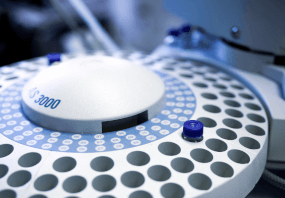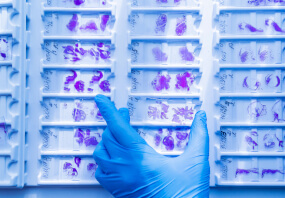General description
Connective tissue is responsible for maintaining the form of the body and its organs and provides cohesion and internal support. It includes several types of fibrous tissue that vary only in their density and cellularity. The cells of connective tissue include fibroblasts and adipose cells that are relatively stationary and several types of motile migrating cells, such as mast cells, macrophages, monocytes, lymphocytes, plasma cells, and eosinophils. These cells of connective tissue develop during embryonic life from the mesenchyme. Fibroblasts are the least specialized cells in the connective-tissue family. They are dispersed in connective tissue throughout the body, where they secrete a nonrigid extracellular matrix that is rich in type I and/or type III collagen. In skin fibroblasts originate from two distinct lineage of cells: one lineage populates the papillary dermis, and the other lineage populates the reticular dermis, that have distinct cell markers and distinct functional abilities. Clone ER-TR specifically detects an antigen present in, and produced by, reticular fibroblasts. This clone is useful to stain the microanatomy of various organs, in particular the connective tissue framework in lymphoid organs. It is also shown to detect reticular fibroblasts in thymus. (Ref.: Van Vliet, E., et al. (1984). Eur. J. Immunol. 14(6); 524-529).
Specificity
Clone ER-TR7 is a rat monoclonal antibody that detects Reticular fibroblasts.
Immunogen
Thymic stromal cells isolated from C3H mice.
Application
Quality Control Testing
Evaluated by Immunohistochemistry in Mouse thymus tissue sections.
Immunohistochemistry Applications: A 1:50 dilution of this antibody detected reticular fibroblasts in frozen section of Mouse thymus tissue.
Tested applications
Immunofluorescence Analysis: A representative lot detected Reticular fibroblasts clone ER-TR7 in Immunofluorescence applications (Van Vliet, E., et al. (1984). Eur J Immunol. 14(6):524-9; Nolte, M.A., et al. (2003). J Exp Med. 198(3):505-12; Sixt, M., et al. (2005). Immunity. 22(1):19-29; Link, A., et al. (2007). Nat Immunol. 8(11):1255-65; Odaka, C., et al. (2009). J Histochem Cytochem. 57(4):373-82; Schiavinato, A., et al. (2021). Eur J Immunol. 51(9):2345-2347).
Immunohistochemistry Applications: A representative lot detected Reticular fibroblasts clone ER-TR7 in Immunohistochemistry applications (Van Vliet, E., et al. (1984). Eur J Immunol. 14(6):524-9; Nolte, M.A., et al. (2003). J Exp Med. 198(3):505-12; Sixt, M., et al. (2005). Immunity. 22(1):19-29; Link, A., et al. (2007). Nat Immunol.;8(11):1255-65; Odaka, C., et al. (2009). J Histochem Cytochem. 57(4):373-82; Schiavinato, A., et al. (2021). Eur J Immunol. 51(9):2345-2347).
Note: Actual optimal working dilutions must be determined by end user as specimens, and experimental conditions may vary with the end user
Anti-Reticular fibroblasts, clone ER-TR7, Cat. No. MABF2804, is a rat monoclonal antibody that detects Reticular fibroblasts and is tested for use in Immunofluorescence and Immunohistochemistry.
Physical form
Purified rat monoclonal antibody IgG2a in buffer containing 0.1 M Tris-Glycine (pH 7.4), 150 mM NaCl with 0.05% sodium azide.
Storage and Stability
Recommended storage: +2°C to +8°C.
Other Notes
Concentration: Please refer to the Certificate of Analysis for the lot-specific concentration.
Disclaimer
Unless otherwise stated in our catalog or other company documentation accompanying the product(s), our products are intended for research use only and are not to be used for any other purpose, which includes but is not limited to, unauthorized commercial uses, in vitro diagnostic uses, ex vivo or in vivo therapeutic uses or any type of consumption or application to humans or animals.
- UPC:
- 42295513
- Condition:
- New
- Availability:
- 3-5 Days
- Weight:
- 1.00 Ounces
- HazmatClass:
- No
- MPN:
- MABF2804-25UG












